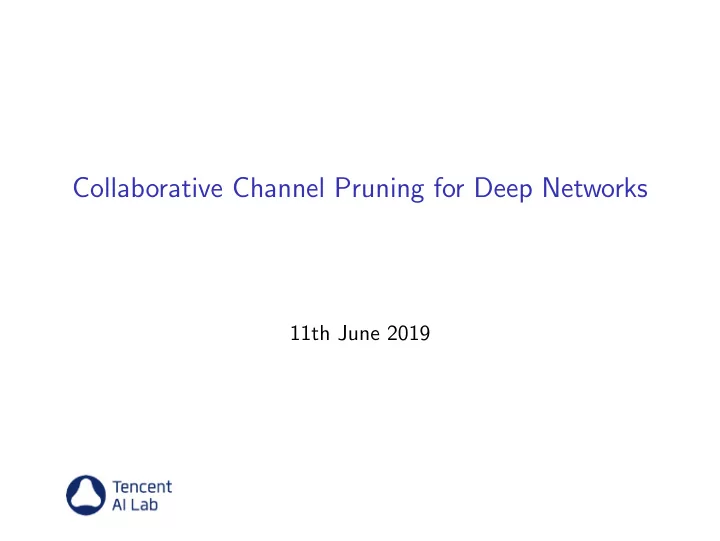

Collaborative Channel Pruning for Deep Networks 11th June 2019
Background Model compression method ◮ Compact network design; Source:https://orbograph.com/ deep-learning-how-will-it-change-healthcare/ ◮ Network quantization; ◮ Channel or filter pruning; Here we focus on channel pruning. Source:http://mypcsupport.ca/portable-devices/
Background Some criterion for channel pruning ◮ Magnitude-based pruning of weights.e.g. ℓ 1 − norm (Li et al.,2016) and ℓ 2 -norm (He et al.,2018a); ◮ Average percentage of zeros (Luo et al., 2017); ◮ First-order information (Molchanov et al., 2017);
Background Some criterion for channel pruning ◮ Magnitude-based pruning of weights.e.g. ℓ 1 − norm (Li et al.,2016) and ℓ 2 -norm (He et al.,2018a); ◮ Average percentage of zeros (Luo et al., 2017); ◮ First-order information (Molchanov et al., 2017); These measures consider channels independently to determine pruned channels.
Motivation We focus on exploiting the inter-channel dependency to determine pruned channels. Problems: ◮ Criterion to represent the inter-channel dependency? ◮ Effects on loss function?
Method We analyze the impact via second-order Taylor expansion: L ( β , W ) ≈ L ( W ) + g T v + 1 2 v T Hv , (1) An efficient way to approximate H . ◮ For least-square loss, H ≈ g T g ; ◮ For cross-entropy loss, H ≈ g T Σ g ; where Σ = diag (( y ⊘ ( f ( w , x ) ⊙ f ( w , x )))).
Method We reformulate Eq.1 to a linearly constrained binary quadratic problem 1 : min β T ˆ S β (2) s.t. 1 T β = p , β ∈ { 0 , 1 } c o . The pairwise correlation matrix ˆ S reflects the inter-channel dependency. 1 More details can be found in our paper
Ƹ Ƹ Ƹ Ƹ Ƹ Ƹ Ƹ Ƹ Ƹ Ƹ Method A graph perspective: 𝑡 2,2 1 2 ◮ Nodes denote channels 𝑡 2,6 𝑡 2,3 ◮ Edges are assigned with the 𝑡 6,6 𝑡 3,3 𝑡 3,6 6 3 corresponding weight ˆ s ij . 𝑡 2,4 ◮ Find a sub-graph such the sum of 𝑡 4,6 𝑡 3,4 included weights is minimized. 𝑡 4,4 5 4
Method Algorithm Compute pairwise 𝑡 𝑗𝑘 correlation matrix Prune filters Fine tune the network
Results Table 1: Comparison on the classification accuracy drop and reduction in FLOPs of ResNet-56 on the CIFAR-10 data set. Baseline Pruned Method Acc. Acc. ↓ FLOPs Channel Pruning (He et al.,2017) 92.80% 1.00% 50.0% AMC (He et al., 2018b) 92.80% 0.90% 50.0% Pruning Filters (Li et al., 2016) 93.04% -0.02% 27.6% Soft Pruning (He et al., 2018a) 93.59% 0.24% 52.6% DCP (Zhuang et al., 2018) 93.80% 0.31% 50.0% DCP-Adapt (Zhuang et al., 2018) 93.80% -0.01% 47.0% CCP 0.08% 52.6% 93.50% CCP-AC -0.19% 47.0%
Results Table 2: Comparison on the top-1/5 classification accuracy drop, and reduction of ResNet-50 in FLOPs on the ILSVRC-12 data set. Baseline Pruned Method Top-1 Top-5 Top-1 ↓ Top-5 ↓ FLOPs Channel Pruning - 92.20% - 1.40% 50.0% ThiNet 72.88% 91.14% 1.87% 1.12% 55.6% Soft Pruning 76.15% 92.87% 1.54% 0.81% 41.8% DCP 76.01% 92.93% 1.06% 0.61% 55.6% Neural Importance - - 0.89% - 44.0% CCP 0.65% 0.25% 48.8% CCP 76.15% 92.87% 0.94% 0.45% 54.1% CCP-AC 0.83% 0.33% 54.1%
Thanks for your attention!
Recommend
More recommend